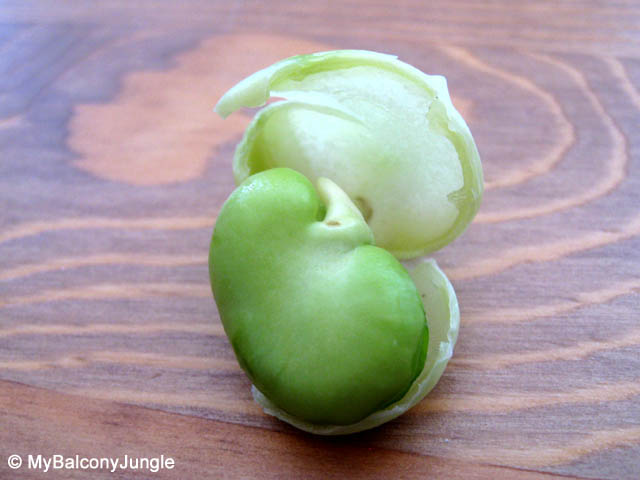Growing Broad Beans in Containers

A few broad bean plants growing in a container on my balcony.
Broad Beans or Fava Beans or Horse Beans or Pigeon Beans... Vicia Faba. They grow like a bush bean but are more like a pea in nature. They are not all that popular in North American gardens so not terribly easy to come by. You can grow them like you would bush beans. They like cool temperatures and wither in the summer heat. And I've found they grow alright in containers. They don't have a very deep root system and are not terribly demanding when it comes to water or nutrients. Just treat them like bush beans and you'll be fine.
Like peas, broad beans are a low yielding plant so plant several. The seeds are huge and the recommended planting depth is something like an inch deep. The plants grow one to two feet tall with a few stems emanating from the base of the plant. My first experience with growing broad beans on the balcony in a large container didn't work out too well. I had lots of growth and lots of flowers but no beans. Not a single pod. Eventually the plants stopped growing all together and were plagued by mildew and aphids. I decided that the beans were not at fault and if I had put them out in a sunnier spot and perhaps watered them a little less, they would have done better.
Not to be deterred I decided to plant a few seeds the following spring. This time I put them in a deep container in the sunniest spot my balcony can offer. The plants were compact but healthy and each produced pods with edible beans inside. I'm quite certain they were a long pod variety but what I got were short pods with anywhere from 1 to 4 beans per pod. By the time the summer heat was peaking, the plants were fading. They were done by July, freeing up the container space for something else.
So what do you do with these things? If you're only growing a few plants as an experiment, you do what I do and eat them raw. I like eating peas raw. Young road beans, when peeled, taste a lot like fresh peas. So eating a handful of raw broad beans was no problem for me. The best time to pick them is when they are young, when the beans are just starting to bulge in the pod. But if you want to go for a more bitter tasting bean, wait until they mature a little more.

The inside of a broad bean pod is filled with a downy fiber that surrounds the bean seeds.

Broad beans have a thick membrane that some people like to peel off before eating.
I use a pair of scissors to clip the pods from the bushes. The pods are quite thick and take a little more effort to open than a typical garden pea. The inside of the pod is filled with a downy fiber that blankets the beans in the their pod. In most cultures, the beans are eaten as they are, especially if you plan to cook them in some way. But you should be aware that the bean is covered with a thick membrane that some people like to peel. I prefer to eat raw broad beans peeled. You can peel them raw but it is a bit of a pain to do so. You can also blanch them in boiling water to soften the skins to make peeling easier but I would only do this if you plan to cook them and absolutely need to have the skins removed.
